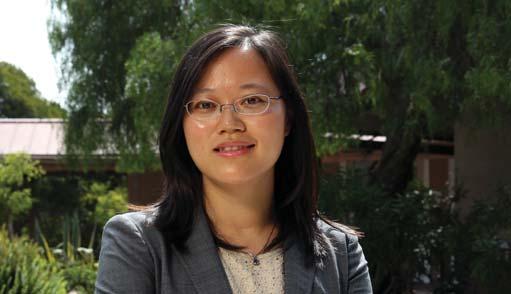
14 minute read
LATEST PUBLICATONS



LATEST LA I PUBLICATIONS TI N
BY MERAGE SCHOOL FACULTY MEMBERS L F FA LT



















ACCOUNTING

PROFESSOR RADHIKA LUNAWAT
Title: “The Impact of Financial Histories on Individuals and
Societies: A Replication and Extension of Berg et. al. (1995)” Co-authors: Xu Jiang and Brian Shapiro Accepted at: Research in Experimental Economics
This paper studies how successive generations of laboratory increase in societal organization as a reduction in the entropy of the distribution of amounts sent and returned by successive generations of players in the Investment Game. Their entropy analysis of data from Berg, Dickhaut, and McCabe (Games entropy of the amounts sent by Investors and amounts returned by Stewards, and marginally reduced the entropy in the joint Investor/Steward distribution. The authors replicated the Berg. et al. (1995) setting and gathered data from three additional societal generations to further test the predictive power of the hypothesis that successive generations of individuals in laboratory societies will increasingly organize themselves undertaken by the preceding generation. Participants in Session participants in the subsequent Sessions II-V received a report preceding session. Thus, Sessions I and II replicate the original Berg et al. (1995) study, and Sessions III-V extend that study. In general, the results across sessions indicate that entropy declined in both the amounts sent by Investors and the percentage returned by Stewards, but these patterns are weaker and mixed compared to those in the Berg et al. (1995) study. The concluding section discusses the implications of the results

PROFESSOR TERRY SHEVLIN
Title: “Measuring Income Tax Accrual Quality” Co-authors: Preeti Choudhary and Allison Koester Accepted at: Review of Accounting Studies
This paper develops and validates a measure of tax accrual quality. Tax accrual quality captures variation in the extent to which the income tax accrual maps into income tax-related cash Low tax accrual quality arises from management estimation captured by deferred tax assets and liabilities. The authors
validate their tax accrual quality measure by showing it is and by demonstrating it predicts future tax-related restatements and internal control material weaknesses. They also illustrate the importance of the measure by showing that investors view quality. The empirical results are incremental to controlling for working capital accruals quality and measures of tax avoidance, tax risk, and tax-related earnings management. Researchers can use this tax accrual quality measure to address questions related to estimation error in the income tax account.
PROFESSOR TERRY SHEVLIN
Title: “Market (In)Attention and the Strategic Scheduling and
Timing of Earnings Announcements” Co-authors: Ed deHaan and Jake Thornock Accepted at: Journal of Accounting and Economics
This paper investigates whether managers “hide” bad news by announcing earnings during periods of low attention, or by providing less forewarning of an upcoming earnings reporting bad news after market hours, on busy days, and with less advance notice, and with earnings receiving less attention managers also report bad news on Fridays, but the researchers Friday earnings announcement, which is consistent with investors inferring forthcoming bad news.
ECONOMICS AND PUBLIC POLICY

PROFESSOR MIREILLE JACOBSON
Title: “The Effect of Medicare on Medical Expenditure Risk and
Financial Strain” Co-authors: Silvia Barcellos Accepted at: American Economic Journal: Economic Policy
Authors of this study sought to estimate the current impact percent among the top 5 percent of spenders, and the fraction of the population with out-of-pocket medical expenditures above such as problems paying bills, is dramatically reduced. Using a stylized expected utility framework, the gain from reducing improvements due to Medicare.
FINANCE

PROFESSOR DAVID HIRSHLEIFER
Title: “Editorial: Cosmetic Surgery in the Academic Review
Process” Accepted at: Review of Financial Studies
Has the academic review process become excessive? In this paper, Hirshleifer describes a model in which reviewers who seek reputations with editors for high skill recommend the repair two, leading in equilibrium to insistence upon cosmetic surgery. Indeed, if there is a chance that blemishes are not removable, in equilibrium editor and reviewer demands sometimes cause good papers to remain unpublished. This implies a socially valuable role for active editing. Signal-jamming incentives may especially means of follow-up papers. This perspective strongly suggests that the increased burden of the review process is undesirable. In conclusion, Hirshleifer offers tentative thoughts about what to do about it. PROFESSOR LU ZHENG

Title: “Does Media Coverage of Stocks Affect Mutual Funds’
Trading and Performance?” Co-authors: Lily H. Fang and Joel Peress Accepted at: Review of Financial Studies
This paper examines the relation between mutual fund trades funds exhibit persistent differences in their propensity to buy media-covered stocks. Moreover, this propensity is related negatively to their future performance. Funds in the highest propensity decile underperform funds in the lowest propensity subject to limited attention.
INFORMATION SYSTEMS

PROFESSOR SANJEEV DEWAN
Title: “What Explains the Variation? Industry-Level Analysis of
Information Technology Risk and Return” Co-authors: Fei Ren (PhD Alumna) Accepted at: Journal of Management Information Systems
Motivated by the wide dispersion in IT returns across industries, researchers conducted an industry- level examination of IT return and risk, focusing on the moderating roles of industry competition, regulation and technological change. They addressed the following research questions: What is the impact of IT investment on the return and risk dimensions of moderate the relationship between IT investment and industry levels of industry competition are associated with higher IT productivity (contribution of IT to value-added output), lower IT higher IT risk (contribution of IT to ex ante variability of ROA). This is consistent with the notion that competition induces riskier IT investments, despite the fact that competition may evaporate returns. Higher levels of industry regulation are associated also with lower IT risk. Finally, a higher rate of technological change induces both higher IT returns and higher IT risk. A variety of tests indicate that our results are robust and together, they shed light on factors that drive variation in IT performance across industries, and provide useful industry-level performance benchmarks of the return and risk impacts of IT investments.

PROFESSOR VIJAY GURBAXANI
Title: “Social Capital and Contract Duration in Buyer-Supplier
Networks for Information Technology Outsourcing” Co-authors: Kiron Ravindran (PhD Alumnus), Anjana Susarla and Deepa Mani Accepted at: Information Systems Research
This paper presents new evidence on the role of embeddedness in predicting contract duration in the context of Information Technology (IT) Outsourcing. Contract duration is a strategic decision that aligns interests of clients and for vendors. Considering the salience of this phenomenon, there has been limited empirical scrutiny into how contract duration is awarded. These researchers posit that clients
inter-organizational network. First, the learning and experience accumulated from being embedded in client-vendor network could mitigate the challenges in managing longer-term contracts. Second, the network serves as a reputation system that can stratify vendors according to their trustworthiness and reliability, which is important in longer-term arrangements. In particular, the researchers attempt to make a substantive contribution in theorizing about embeddedness at four distinct levels: structural embeddedness at the node level, relational embeddedness at the dyad level, contractual embeddedness at the level of a at the level of the entire network. They analyzed a dataset of with the relational embeddedness of the buyer-seller dyad and with the duration of other contracts to which it is connected given the unobserved errors being clustered along two non (here the contract) with those of contracts in its reference group. They employed a multi-way cluster robust estimation and a network auto-regressive estimation to address these issues. Implications for literature and practice are discussed.
MARKETING

PROFESSOR IMRAN CURRIM
Title: “When Does Metric Use Matter Less? How Firm and
Managerial Characteristics Moderate the Relationship between
Metric Use and Marketing Mix Performance” Co-authors: Ofer Mintz (PhD Alumnus) Accepted at: European Journal of Marketing
In an effort toward building a contingent theory of drivers and consequences of managerial metric use in marketing mix decisions, this paper develops a conceptual framework to test whether the relationship between metric use and marketing resource based, and decision maker based theories, and 22 managerial interviews, a conceptual model is proposed. The model is tested via generalized least squares seemingly more market oriented, larger, and with worse recent business performance; and for marketing and higher level managers; while organizational involvement has a lesser nuanced effect. strategies to improve marketing mix performance based on metric use.

PROFESSOR SREYA KOLAY
Title: “Manufacturer-Provided Services vs. Retailer-Provided
Services: Effect on Product Quality, Channel Profits and
Consumer Welfare” Accepted at: International Journal of Research in Marketing
Demand-enhancing services and activities such as advertising, technical support, delivery and installation services are routinely offered to consumers by manufacturers or retailers or both. Examples of such advertising include Verizon Wireless advertising the Samsung Galaxy 4 smartphone versus Samsung advertising the Galaxy 4 smartphone by itself, and examples technical support versus the manufacturer providing the technical support for its product.
This paper develops a game theoretic model to examine how the identity of the channel member (manufacturer or retailer) providing the demand-enhancing services can have a different resultant channel and consumer welfare. In their analysis, researchers take the identity of who provides services in the exogenous circumstances like location of the manufacturer or prior negotiations, and study the strategic implications of manufacturer-provided services versus retailer-provided services.
The researchers show that when a manufacturer wishing to sell its product line through a retailer provides demandenhancing services to consumers, then it chooses higher consumer welfare are higher. However, when the retailer the demand-enhancing services, then the manufacturer may levels in situations where it carries the partial product line, i.e., in situations not desired by the manufacturer. This in turn necessitates larger inducements paid by the manufacturer to the retailer for it to choose to carry the entire product line. The manufacturer internalizes this potential retailer opportunism in its product design stage and adjusts product quality downward those undesired paths. This product quality decision in turn consumers. Our results therefore indicate that a manufacturer should not simply look at cost savings arising from shifting service responsibilities from itself to the retailer. Similarly, a where it has secured the ability to choose its own desired levels of services to be provided to consumers.
OPERATIONS AND DECISION TECHNOLOGIES

PROFESSOR LUYI GUI
Title: “Efficient Implementation of Collective Extended Producer
Responsibility Legislation” Co-authors: Atalay Atasu, Ozlem Ergun and Beril Toktay Accepted at: Management Science
Extended Producer Responsibility (EPR) is a policy tool collection, recycling and disposal of their products. Many EPR allocated to producers based on metrics such as their return shares by weight. Such weight-based proportional allocation mechanisms are criticized in practice for not taking into account products. The consequence is cost allocations that impose higher costs on certain producer groups than they can achieve independently, which may lead some producers to break away from collective systems, resulting in fragmented systems with producer concern.
To address this concern, this paper develops cost allocation mechanisms that induce participation in collective systems and propose consist of adjustments to the widely used return share method, and include the weighing of return shares based on processing costs and the rewarding of capacity contributions to collective systems. Researchers validate their theoretical results using Washington state EPR implementation data and provide insights as to how these mechanisms can be implemented in practice.
ORGANIZATION AND MANAGEMENT

PROFESSOR CHRISTOPHER W. BAUMAN
Title: “Diverse According to Whom? Racial Group Membership and
Concerns About Discrimination Spare Diversity Judgments” Co-authors: Sophie Trawalter and Miguel M. Unzueta Accepted at: Personality and Social Psychology Bulletin
People often treat diversity as an objective feature of situations that everyone perceives similarly. Current research shows, however, that disagreement often exists over whether a group is diverse. These researchers argue that diversity
judgments diverge because they are social perceptions that including concerns about how a group would treat them. Therefore, whether a group includes in-group members should affect how diverse a group appears because the inclusion or apparent exclusion of in-group members signals whether perceivers can expect to be accepted and treated fairly. Supporting their claims, three experiments demonstrate that racial minority group members perceive more diversity when groups included racial in-group members rather than members of other racial minority groups. Moreover, important differences exist between Asian Americans and African Americans, which underscore the need for more research to explore uniqueness rather than commonalities across racial minority groups.
PROFESSOR CHRISTOPHER W. BAUMAN
Title: “Revisiting External Validity: Concerns about Trolley
Problems and Other Sacrificial Dilemmas in Moral Psychology” Co-authors: A. Peter McGraw, Daniel M. Bartels and Caleb Warren Accepted at: Social and Personality Psychology Compass
moral situations; they are now a familiar part of the behavioral and the popular press. These researchers were concerned that and psychological realism and therefore suffer from low external validity. Their apprehensions stemmed from three observations they are amusing rather than sobering, (ii) they are unrealistic and unrepresentative of the moral situations people encounter in the real world, and (iii) they do not elicit the same psychological processes as other moral situations. The researchers believed it would be prudent to use more externally valid stimuli when testing descriptive theories that aim to provide comprehensive accounts of moral judgment and behavior. PROFESSOR JONE PEARCE

Title: “Cronyism and Nepotism Are Bad for Everyone: The Research
Evidence” Accepted at: Industrial and Organizational Psychology
A review of systematic and rigorous research provides strong evidence to support the experience-based perceptions of practitioners that nepotism and cronyism damage employees, their supervisors and produce poorer organizational performance. This is because nepotism places loyalty and It is not reasonable to expect people to abandon the love and support of their families, the primary sources of our identities, complicated than nepotism and entwined with meritocracy in ways not yet fully understood.
PROFESSOR JONE PEARCE
Title: “Managing the Unknowable: The Effectiveness of Early-Stage
Investor Gut Feel in Entrepreneurial Investment Decisions” Co-authors: Laura Huang (PhD Alumna) Accepted at: Administrative Science Quarterly
criteria for investment decisions. Building on existing decision making, entrepreneurial and organizational theory to propose theoretical contributions to early-stage investment decisions when risks are unknowable, how angels use both intuition and formal analysis to achieve their objective of few extraordinarily have several characteristics that have not been adequately captured in existing work: angel investors have clear objectives than seeking to maximize return on each investment, they rely on a combination of expertise-based intuition and formal analysis in which the formal analysis does not undermine intuition, and their reported criteria accurately predict researchers developed this theory by examining situations in but in this case investors actively seek out such investments because they believe this is where the extraordinary returns can be found. Researchers propose using the term of “gut feel,” to interplay of intuition and analysis that is dominated by intuition, when risks are unknowable. PROFESSOR SHUYA YIN

Title: “Joint Selling of Complementary Components Under Brand and Retail Competition” Co-authors: Yuhong He (PhD Alumna) Accepted at: Manufacturing and Service Operations Management
Suppliers of complementary goods often package their items together when selling to downstream retailers. One motivation behind this behavior is to reduce double marginalization through is to understand how competition in supply chains would impact such joint selling partnerships among complementary suppliers. is generated from the existence of multiple partially substitutable brands (or suppliers) for a particular component. They then extended the analysis to a model which also involves retail competition that is caused by decentralization among retailers to customers. The analysis of a model with two complementary components, one of which has multiple brands, indicates that the supply level competition discourages joint selling of complementary goods. That is, when competing brands become more alike (or substitutable), complementary suppliers act more independently in pricing and selling their items. However, retail competition leads to an opposite effect: Competition among retailers would actually encourage complementary suppliers to package their goods together and act jointly.






